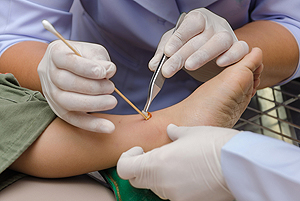Diabetes and Foot Ulcers
Monday, 23 December 2019 00:00 Wound care is generally a familiar concern for diabetic patients. When the insulin levels are elevated for an extended period of time, there may be a loss of feeling as a result of neuropathy. A small cut or scrape on the foot may have the potential of developing into a dangerous wound, and prompt treatment is necessary in possibly preventing a painful foot ulcer. Proper treatment may begin with cleaning the affected area thoroughly, followed by applying an antibiotic cream. It is important the wound is covered, and this may help to prevent bacteria from multiplying at the site of the foot ulcer. If you are affected by diabetes, it is strongly suggested that you are under the care of a podiatrist who can help this condition.
Wound care is generally a familiar concern for diabetic patients. When the insulin levels are elevated for an extended period of time, there may be a loss of feeling as a result of neuropathy. A small cut or scrape on the foot may have the potential of developing into a dangerous wound, and prompt treatment is necessary in possibly preventing a painful foot ulcer. Proper treatment may begin with cleaning the affected area thoroughly, followed by applying an antibiotic cream. It is important the wound is covered, and this may help to prevent bacteria from multiplying at the site of the foot ulcer. If you are affected by diabetes, it is strongly suggested that you are under the care of a podiatrist who can help this condition.
Wound care is an important part in dealing with diabetes. If you have diabetes and a foot wound or would like more information about wound care for diabetics, consult with Dr. Kirk Sherris from Liberty Bay Foot & Ankle. Our doctor will assess your condition and provide you with quality foot and ankle treatment.
What Is Wound Care?
Wound care is the practice of taking proper care of a wound. This can range from the smallest to the largest of wounds. While everyone can benefit from proper wound care, it is much more important for diabetics. Diabetics often suffer from poor blood circulation which causes wounds to heal much slower than they would in a non-diabetic.
What Is the Importance of Wound Care?
While it may not seem apparent with small ulcers on the foot, for diabetics, any size ulcer can become infected. Diabetics often also suffer from neuropathy, or nerve loss. This means they might not even feel when they have an ulcer on their foot. If the wound becomes severely infected, amputation may be necessary. Therefore, it is of the upmost importance to properly care for any and all foot wounds.
How to Care for Wounds
The best way to care for foot wounds is to prevent them. For diabetics, this means daily inspections of the feet for any signs of abnormalities or ulcers. It is also recommended to see a podiatrist several times a year for a foot inspection. If you do have an ulcer, run the wound under water to clear dirt from the wound; then apply antibiotic ointment to the wound and cover with a bandage. Bandages should be changed daily and keeping pressure off the wound is smart. It is advised to see a podiatrist, who can keep an eye on it.
If you have any questions, please feel free to contact our office located in Poulsbo, WA . We offer the newest diagnostic and treatment technologies for all your foot care needs.







